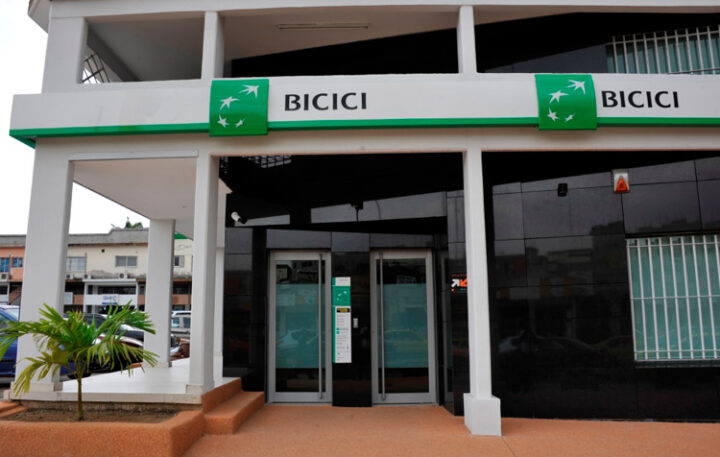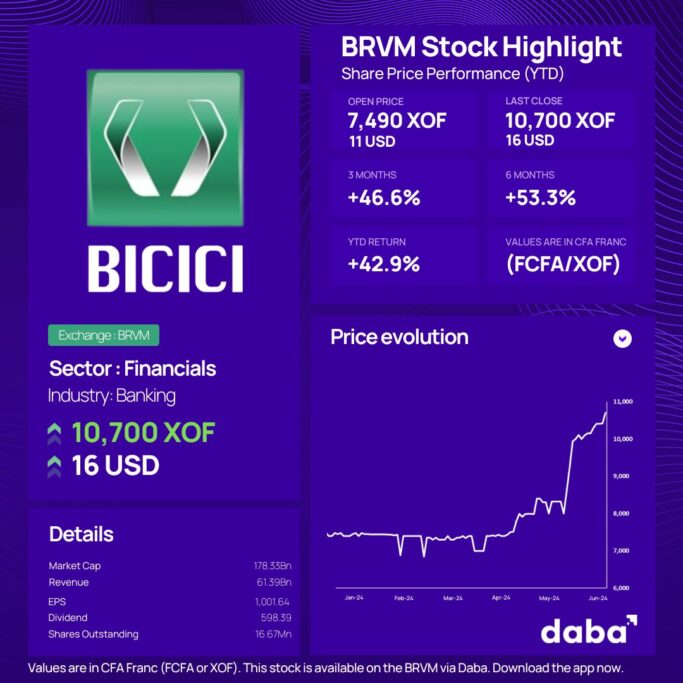NSIA a réussi non seulement à maintenir, mais aussi à améliorer sa performance financière, se positionnant ainsi comme un acteur clé du secteur bancaire ivoirien.
NSIA Banque Côte d’Ivoire (NSIA) a démontré sa résilience financière et sa croissance au cours du premier semestre 2024, malgré un environnement économique mondial difficile.
Alors que le monde se remet lentement des perturbations causées par les crises mondiales des dernières années, NSIA a réussi à non seulement maintenir, mais aussi à améliorer sa performance financière, se positionnant ainsi comme un acteur clé du secteur bancaire ivoirien.
Performance Financière et Croissance des Bénéfices
La performance financière de NSIA Banque au premier semestre 2024 a été impressionnante. Le Produit Net Bancaire de la banque a augmenté de 10,3 % d’une année sur l’autre, atteignant 45,7 milliards de FCFA (78 millions de dollars), contre 41,4 milliards de FCFA au même trimestre de 2023. Cette croissance reflète la capacité de la banque à générer plus de revenus grâce à ses activités bancaires principales malgré les incertitudes économiques plus larges.
Un aspect notable des bénéfices de NSIA est l’augmentation significative de son revenu net. La banque a enregistré un bénéfice net de 14,528 milliards de FCFA, marquant une hausse substantielle de 27,5 % par rapport aux 11,4 milliards de FCFA gagnés au premier semestre 2023. Cette augmentation de la rentabilité souligne la gestion efficace des coûts de NSIA et les initiatives stratégiques visant à stimuler la croissance des revenus tout en maîtrisant les coûts opérationnels.
Rentabilité et Efficacité Opérationnelle
L’efficacité opérationnelle de la banque a également enregistré des progrès positifs. Les charges d’exploitation ont augmenté de 9 %, passant de 21,3 milliards de FCFA en juin 2023 à 23,2 milliards de FCFA en juin 2024.
Malgré cette augmentation des coûts, NSIA a réussi à améliorer légèrement son ratio coût/revenu, qui est désormais de 59,9 %, contre 60,4 % un an plus tôt. Cette amélioration, bien que marginale, indique que NSIA devient plus efficace dans la conversion de ses revenus en bénéfices, ce qui est un bon signe pour les actionnaires à la recherche de création de valeur.
De plus, le résultat brut d’exploitation a augmenté de 12 %, passant de 16,4 milliards de FCFA en juin 2023 à 18,3 milliards de FCFA en juin 2024. Cette augmentation reflète la capacité de la banque à maintenir des gains solides avant impôts et coûts de risque, renforçant ainsi sa rentabilité.
Un des signes les plus encourageants pour les investisseurs est la réduction significative du coût du risque. Le coût net du risque est passé de -3,7 milliards de FCFA en juin 2023 à -2,7 milliards de FCFA en juin 2024. Cette réduction d’environ 27 % met en évidence les efforts réussis de la banque pour gérer le risque de crédit, ce qui est crucial pour maintenir la rentabilité à long terme et protéger la valeur actionnariale.
Solidité du Bilan et Qualité des Actifs
Le bilan de NSIA Banque reflète une base solide qui soutient sa rentabilité continue. Le total des actifs a augmenté de 6 % passant de 2 037 milliards de FCFA en décembre 2023 à 2 159 milliards de FCFA en juin 2024. Cette croissance des actifs est principalement due à une augmentation de 6 % des prêts aux clients, qui sont passés de 1 307 milliards de FCFA à 1 382 milliards de FCFA au cours de la même période.
La capacité de la banque à accorder plus de crédits, en particulier aux petites et moyennes entreprises (PME), démontre son engagement à favoriser la croissance économique en Côte d’Ivoire tout en augmentant ses actifs générateurs de revenus.
Du côté des passifs, les dépôts de la clientèle ont augmenté de 7 %, passant de 1 415,9 milliards de FCFA en décembre 2023 à 1 511,4 milliards de FCFA en juin 2024. Cette augmentation des dépôts, en particulier dans les comptes à vue, les comptes d’épargne et les dépôts de garantie, indique une confiance croissante des clients dans la stabilité et les offres de services de NSIA Banque.
Il convient toutefois de noter que le portefeuille de titres de NSIA a diminué de 5 %, reflétant une approche prudente face à la volatilité des marchés et un éventuel changement stratégique vers des activités bancaires plus traditionnelles, qui offrent généralement des rendements plus stables.
Performance Boursière et Implications pour le Marché
D’un point de vue boursier, l’action NSIA Banque (NSBC) a offert des rendements remarquables à ses investisseurs.
Le prix de l’action de la banque a commencé l’année à 6 000 XOF et a depuis augmenté de 8,25 %, surpassant de nombreux concurrents sur la Bourse Régionale des Valeurs Mobilières (BRVM). Cette appréciation des prix place NSIA Banque comme la 26e action la plus performante sur la BRVM en termes de performance annuelle, ce qui est une réalisation notable compte tenu du paysage concurrentiel.
De plus, NSIA Banque est actuellement la 11e action la plus valorisée sur la BRVM, avec une capitalisation boursière de 161 milliards XOF. Cette valorisation représente environ 1,72 % du marché total des actions sur la BRVM, soulignant le rôle significatif de NSIA dans l’écosystème financier régional.
Pour les actionnaires, la solide performance financière et l’appréciation de l’action de NSIA Banque présentent une proposition d’investissement attrayante.
La capacité de la banque à augmenter ses bénéfices, à améliorer son efficacité opérationnelle et à maintenir la qualité de ses actifs dans un contexte d’incertitude économique est susceptible de continuer à alimenter l’appréciation du prix des actions et à créer de la valeur pour les actionnaires. La rentabilité soutenue et les stratégies de gestion prudente des risques renforcent encore l’attrait de NSIA Banque en tant qu’investissement fiable dans les marchés financiers de l’Afrique de l’Ouest.
Conclusion
La performance financière de NSIA Banque Côte d’Ivoire au premier semestre 2024 reflète une institution bien gérée qui non seulement résiste aux défis économiques de l’ère post-pandémique, mais prospère également. La croissance significative des bénéfices, combinée à l’amélioration de la rentabilité et à un bilan solide, positionne NSIA Banque comme un acteur de premier plan dans le secteur bancaire ivoirien.
Pour les actionnaires, la santé financière robuste de la banque et l’impressionnante performance boursière sont synonymes de rendements prometteurs et de création de valeur à long terme. À mesure que NSIA Banque continue de mettre en œuvre ses initiatives stratégiques et d’améliorer son efficacité opérationnelle, elle reste une opportunité d’investissement convaincante sur le marché des actions de la BRVM.




